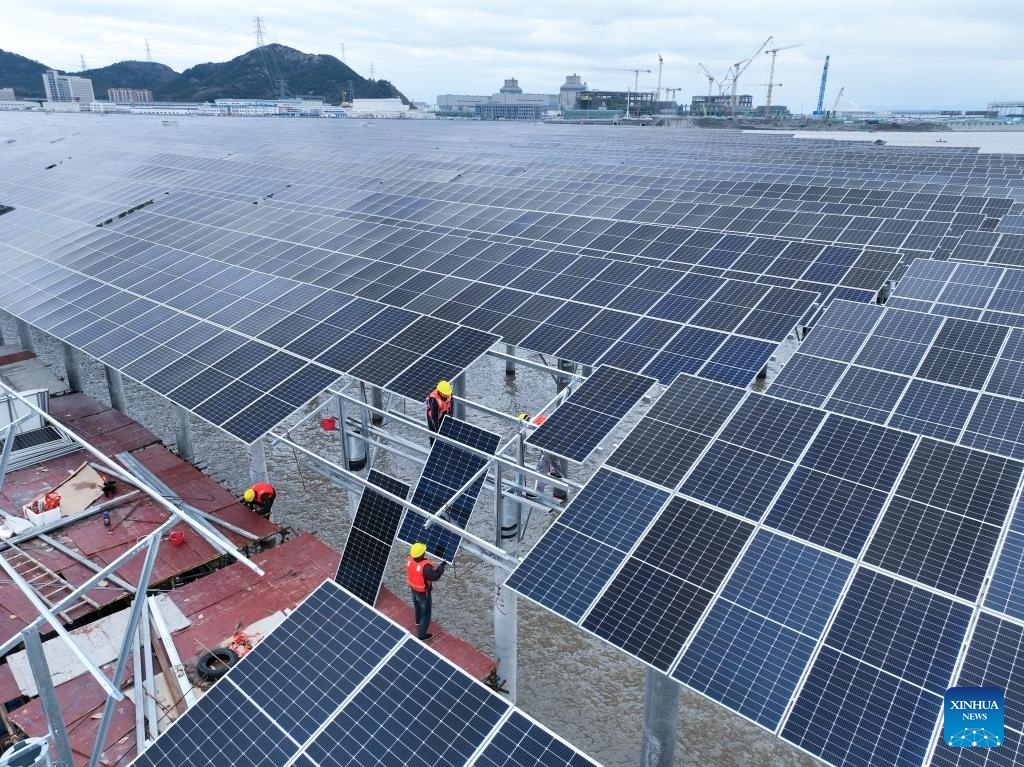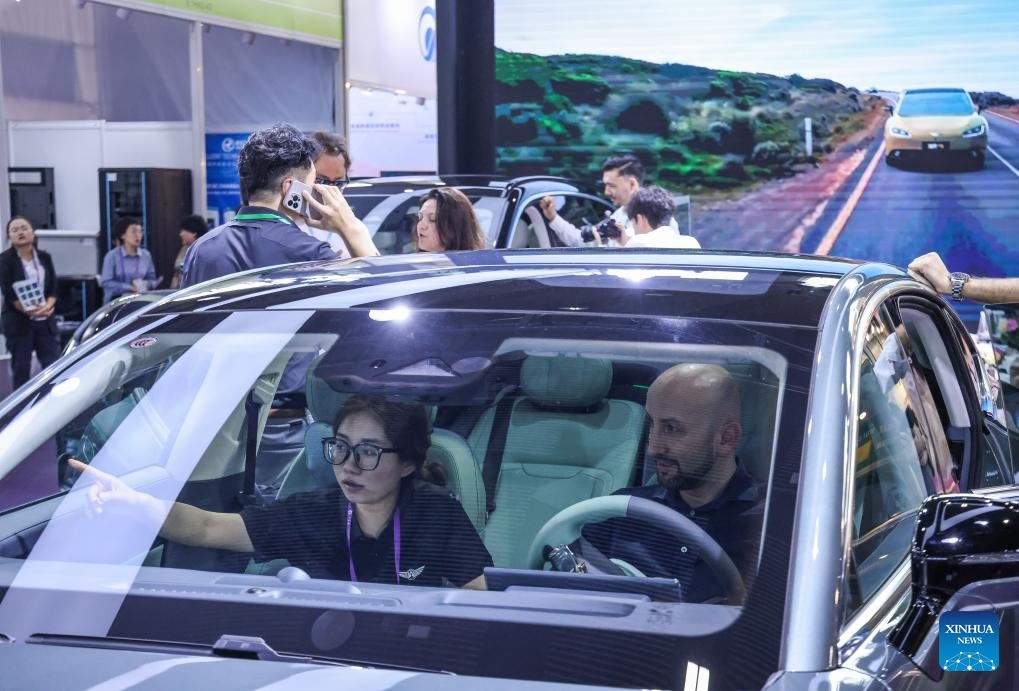US claims of China's 'overcapacity' groundless
Last year, China's exports of "new three" products—new energy vehicles (NEVs), photovoltaic products, and lithium batteries—surpassed 1 trillion yuan ($138 billion) for the first time, growing nearly 30 percent.

Vehicle carrier vessel "BYD Explorer NO.1" arrives at Xiaomo International Logistics Port in Shenzhen, South China's Guangdong Province, Jan. 14, 2024. (Photo: Xinhua)
Many people in the international business community have praised China for its firm promotion of green transformation.
However, some people in the US have labeled China as "overcapacity," arguing that the abundance of exported goods indicates a production capacity that surpasses both China's domestic demand and the capacity of the global market to absorb them.
Such an argument is entirely untenable.
"This overcapacity idea is that you shouldn't produce more than you can sell domestically. If that was carried to an extreme, that would mean no trade globally," said Nicholas Lardy, a senior fellow at Washington DC-based think tank the Peterson Institute for International Economics.
"This would be a complete and utter disaster for every economy."
As economic globalization develops, different countries divide labor and cooperate, each fully exploiting their comparative advantages and exchanging what they need through international trade. This leads to technological progress, improved efficiency and win-win cooperation.
Some people in the West believe that a country has reached "overcapacity" when its production capacity exceeds its own demand. According to that logic, the US exporting large quantities of chips, aircraft, soybeans and other commodities every year is also "overcapacity."
To equal "too many export commodities" with "overcapacity" is already a wrong argument. If you analyze it carefully, it goes against the facts and is fabricated out of thin air.

An aerial drone photo taken on March 26, 2024 shows staff members installing photovoltaic panels in the tidal area in Sanmen county of Taizhou City, East China's Zhejiang Province. (Photo: Xinhua)
Are China's exports of new energy products really too much?
Regarding growth rate, China's exports of "new three" products—NEVs, photovoltaic products and lithium batteries—have become popular globally in the past two years, achieving rapid export growth.
However, in proportion, the ratio of export to production for Chinese NEVs is far lower than that of Germany, Japan and the Republic of Korea. For example, Germany produced 4.1 million cars last year, of which 3.1 million were exported overseas, the ratio of export to production arrived at nearly 80 percent. Last year, China produced approximately 9.587 million NEVs and exported 1.203 million, with the export ratio to production at only one-eighth.
Bloomberg columnist David Fickling in an opinion piece pointed out that the West is concerned about China's impact on the world with new energy products, but the share of related technology products in China's exports is still relatively small.
Is China's green production capacity really "surplus"?
We should view the issue of production from a market perspective.
Under market economy conditions, the balance between supply and demand is relative, and disequilibrium is common. Moderate oversupply is conducive to promoting market competition and the survival of the fittest, technological innovation and cost reduction, and enabling consumers from all countries to obtain higher-quality products and services at a lower cost.
In other words, fair competition is the original meaning of a market economy and an important driving force for the progress of human society. It is a common rule for businesses in the "global village."
Oliver Zipzer, chairman of Germany's BMW Group, has a much more objective view. He thinks that they do not feel a threat, there is no need to exaggerate the fear of foreign manufacturers, and they actually see more opportunities than risks.
Price is an important indicator of the supply-demand relationship. If, as some people in the US have stated, that China has excess production capacity, then China's new energy products in the international market should continue to be priced at a low level.
However, as China's exports of electric vehicles increase, prices also rise. The average price of China's leading electric vehicles in Europe is about twice that of China's domestic market. The increase in quantity and price clearly indicates a supply shortage, so where's the so-called "overcapacity"?

A purchaser learns about an electric vehicle during the 135th session of the China Import and Export Fair in Guangzhou, South China's Guangdong Province, April 15, 2024. (Photo: Xinhua)
We should also view the issue of production from a global perspective.
A country's industrial development must meet the needs of its citizens as much as possible. China is fostering a new development paradigm featuring dual circulation, in which domestic and overseas markets reinforce each other, with the domestic market as the mainstay. The enormous potential for domestic demand provides vast development space for Chinese enterprises.
There is still significant growth potential for new energy vehicles in China's third and fourth-tier cities and rural markets. An analysis predicts that the penetration rate of new energy vehicles in China will increase from 35.2 percent in 2023 to 60 percent in 2033. In other words, meeting the ever-growing needs of over 1.4 billion Chinese people for a better life can only be achieved with the development of the new energy industry and the improvement of production capacity and technological level. For this point, no one has the right to blame it.
A country's industrial development should focus on the overall global industrial context. In order to address climate change, more than 130 countries around the world have set carbon neutrality and emission peak targets, and the demand for green development will continue to grow.
According to the International Energy Agency, the global demand for NEVs will reach 45 million by 2030, more than four times that of 2022. The global demand for new photovoltaic installations will reach 820 gigawatts, about four times higher than in 2022.
New energy products are in short supply on the global market. China needs to participate actively in this field as an essential producer of green products.
In fact, in the field of new energy, Chinese companies are continuing to make contributions to the world. In Hungary, BYD Auto is embarking on the phased construction of a new energy vehicle production base, which is expected to create thousands of local jobs. In Thailand, China Changan Automobile Group, SAIC Motor, BYD Auto and other enterprises are actively building factories, with a total planned investment of more than 10 billion yuan.
Whether exporting products to meet the needs of the global market or building factories overseas to boost investment, drive employment and stimulate industry growth, China's new energy enterprises have always pursued mutual benefit, win-win situations and common development.
It has also won many international plaudits. US magazine The Diplomat mentioned that the Southeast Asian countries' active pursuit of cooperation with Chinese electric vehicle companies strengthens the inevitable transition from fossil-fueled to electric vehicles and promotes economic growth through technology exchanges.
Since it is groundless, why do some people in some countries stubbornly fabricate the "overcapacity" rhetoric of China's new energy industry?
Behind their so-called "irrefutable evidence" lies the "evil intent" of trade protectionism. French entrepreneur Arnaud Bertrand hit the nail on the head. He recently said on X, formerly known as Twitter, that "the real issue here is, in fact, not one of industrial capacity but one of competitiveness." He said that some people in the West fear that "if things keep going, China will simply eat everyone's lunch."
Facts and truths do not differ just because some people label them with a hegemonic mindset and claim to have the "right to interpret." Short-sighted trade protectionism will tie up the development of the global new energy industry and undoubtedly weaken countries' ability to address climate change and promote green development. Ultimately, it will result in sowing the wind and reaping the whirlwind.
International trade is not a zero-sum game. No countercurrent can stop the tide of inclusive economic globalization. Only by following the principles of openness, cooperation and mutual benefit can the global market for green products grow bigger. Only then will humankind have a brighter future.
(Translated by He Jieqiong, Lyu Murong and Zhang Jingjie and edited by Xu Zheqi and Zhan Huilan)
Photos
Related Stories
- Senior CPC official meets Aspen Institute delegation
- Tianjin, Philadelphia celebrate 45th anniversary of sister city ties
- Chinese foreign ministry official on U.S. secretary of state's upcoming visit to China
- FM spokesperson refutes western accusation of "overcapacity"
- Swiss media: Western complaint over 'China's overcapacity' hypocritical, shortsighted
- U.S. notion of "China's overcapacity" a complete fallacy
Copyright © 2024 People's Daily Online. All Rights Reserved.









